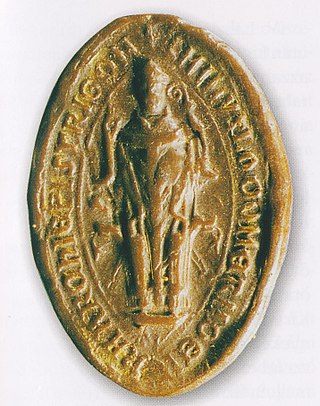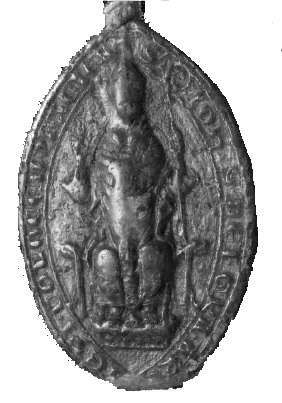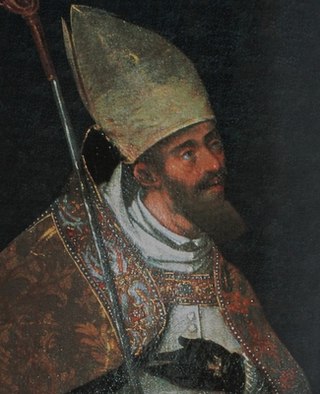Stephen (II) from the kindred Csák was a Hungarian noble who served as Wildgrave of Bakony in 1280.

Lodomer was a prelate in the Kingdom of Hungary in the second half of the 13th century. He was Archbishop of Esztergom between 1279 and 1298, and Bishop of Várad from 1268 till 1279. He was an opponent of Ladislaus IV of Hungary whom he excommunicated for failing to force the Cumans to adopt the Christian way of life. After Ladislaus' death, Lodomer and his suffragans were dedicated supporters of Andrew III of Hungary, who aimed to restore strong royal power against the rebellious lords and oligarchs.
Gregory Bicskei was a prelate in the Kingdom of Hungary at the turn of the 13th and 14th centuries. He was the elected Archbishop of Esztergom between 1298 and 1303. Supporting the claim of the Capetian House of Anjou, he was a tough opponent of Andrew III of Hungary. He crowned Charles I king with a provisional crown in 1301. He was murdered in Anagni by soldiers whom Philip IV of France had sent to Italy to capture Pope Boniface VIII.

John Hont-Pázmány was a prelate in the Kingdom of Hungary at the turn of the 13th and 14th centuries. He was Archbishop of Kalocsa between 1278 and 1301. In this capacity, he closely cooperated with fellow Archbishop Lodomer in order to restore royal authority over the kingdom. After Lodomer's death, John became head of the royal council from 1298 to 1301, initiating profound constitutional changes in the parliamentary system. He crowned Wenceslaus, one of the pretenders to Hungary, king in 1301, provoking the wrath of the Holy See.

Ivan Kőszegi was an influential lord in the Kingdom of Hungary at the turn of the 13th and 14th centuries. Earlier historiographical works also refer to him Ivan Németújvári. He was Palatine in 1281, between 1287 and 1288, and from 1302 until 1307, Ban of Slavonia in 1275, from 1284 until 1285 and in 1290, and Master of the treasury in 1276 and 1291.

Peter (II) from the kindred Monoszló was a Hungarian prelate, who served as the Bishop of Transylvania from 1270 until his death. The current St. Michael's Cathedral in Gyulafehérvár was built during his term.
Paul from the kindred Szécs, also known as Paul of Komárom, was a Hungarian nobleman and landowner who was lord of Komárom from the 1280s. He came to prominence during the last regnal years of Andrew III of Hungary.

Michael from the kindred Bő, was a Hungarian prelate at the turn of the 13th and 14th centuries, who served as Bishop of Zagreb from 1296 to 1303, then Archbishop of Esztergom from 1303 until his death.
Gregory from the kindred Péc was a Hungarian baron and soldier in the 13th century, who served as Judge royal in 1288. He was a forefather of the late medieval powerful Marcali family.
Dominic (II) from the kindred Rátót was a Hungarian powerful lord at the turn of the 13th and 14th centuries, who served as Palatine of Hungary from 1315 to 1320. At the beginning of his career, he was a staunch supporter of Andrew III of Hungary, serving his Master of the treasury for a decade. He retained his office after the extinction of the Árpád dynasty too, during the short reign of Wenceslaus.

Peter Kőszegi was a Hungarian prelate in the 13th century, who served as Bishop of Veszprém from 1275 until his death. He was also unrecognized Archbishop-elect of Esztergom between 1277 and 1278. As a member of the powerful Kőszegi family, he subordinated his diocese to his family's political interests in order to extend their influence over Western Hungary.
Emeric was a Hungarian prelate at the turn of the 13th and 14th centuries, who served as Bishop of Várad from 1297 until his death.
Thomas (III) from the kindred Hont-Pázmány was a Hungarian influential lord in the second half of the 13th century, who served as Judge royal in 1275 and from 1291 to 1293. He was a strong confidant of Andrew III of Hungary.
Andrew (II) from the kindred Hont-Pázmány was a Hungarian medieval soldier in the second half of the 13th century. He was the progenitor of the influential Forgách family.
Ivánka (III) from the kindred Hont-Pázmány was a Hungarian medieval soldier in the second half of the 13th century.

Andrew was a Hungarian prelate at the turn of the 13th and 14th centuries, who served as Bishop of Eger from 1275 until his death.
Haab was a Hungarian prelate at the turn of the 13th and 14th centuries, who served as Bishop of Vác from 1294 until his death.

Simon (II) Nagymartoni was a Hungarian lord in the second half of the 13th century, who served as ispán of Bars County from 1277 to 1278.
Anthony was a Hungarian Franciscan friar and prelate at the turn of the 13th and 14th centuries, who served as Bishop of Csanád from around 1298 until his death. He was a confidant of Andrew III of Hungary, serving his vice-chancellor in his last regnal years. During the era of Interregnum, he supported the claim of Wenceslaus then Otto against Charles I. Serving him as chancellor, he crowned the latter with the Holy Crown in 1305.
Ladislaus from the kindred Aba was a Hungarian cleric in the second half of the 13th century, who served as Provost of Titel from around 1280 to 1299. He was vice-chancellor in the court of Andrew III of Hungary in 1299.







